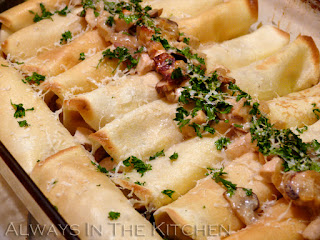
I've always loved the enticing little dishes of blanched spinach dressed with sesame that one finds in Japanese cuisine. My earliest attempts at making them at home were somewhat laughable - I firmly believed that I shouldn't need to cut the spinach, despite all evidence to the contrary - but what I really disliked was the step of squeezing the water out of the cooked vegetable. I didn't like the squeezing, and I didn't like the look of the spinach after I was done. I was doing it utterly wrong.
Happily, this recipe does not require squeezing of any kind. I make no claims for culinary authenticity, of course, and I must confess that this is ultimately an outgrowth of an Italian recipe for balsamic-glazed kale with pine nuts, of which I am also very fond. I can say without hesitation that this dish is both a delightful addition to any lunchbox that wants a little extra vegetable, and a perfect companion to a rice or noodle based dinner. There are many different dressing recipes for a Japanese gomaae, so if this one doesn't strike your fancy, I suggest that you keep the method and substitute the dressing of your preference.
One of the delightful things about kale is that it is quite sturdy. While it does require a bit of preparation to clean, remove central stalk, and slice the kale (see below), you can do this ahead and keep it crisp and ready for a few days, in a sealed container in the fridge. Then, dishes such as this become a snap to pull off at the last second when you decide that you really should have some sort of vegetable with your chicken teriyaki or tonkatsu, or even miso halibut cheeks.
Kale Gomaae
Serves 2 - 4
250 grams lacinato kale, cleaned and prepared (see below)
1 tablespoon lower sodium soy sauce
1 tablespoon mirin
1 teaspoon sesame oil
1/2 teaspoon honey (or agave)
1 teaspoon sesame seeds, lightly crushed
1/2 teaspoon sesame seeds, for garnish
Combine the soy sauce, mirin, sesame oil, and honey/agave with the crushed sesame seeds. Set aside.
Run cold water over your prepared kale, drain immediately. The water still clinging to the leaves is desirable, to provide steam. In a medium skillet or wok (I use a 9" steel skillet - nonstick is not necessary), over high heat, place the prepared and drained kale and begin to move the kale around as it wilts (I use a silicone spatula). If necessary, sprinkle a little more water over the kale, and continue to stir it around until the leaves start to become tender, but are still bright-looking (well, as bright as "black kale" gets, anyway).
Add the combined sauce mixture, and continue to stir until the dressing has been evenly stirred through and each leaf is lightly dressed. Remove to serving bowls, and garnish with extra sesame seeds.
The kale can be served warm or cold.
I plan to serve it the next time I make the Miso Halibut cheeks mentioned above, in fact (which is likely going to be soon, because that sounds really good). Incidentally, you can see one of my messy spinach gomaae attempts over in that link, too.
How To Prepare Lacinato Kale - in pictures
For long leaves, I cut them in half to make them easier to manage

Cut along the spine of the leaf, as close as you possibly can

Turn the leaf around, slice the spine off and discard

Repeat with the other half of the leaf


Stack the leaves and slice into ribbons

If you want to store them for a few days, use a container with a good seal, and place a dampened paper towel on the top before closing. Store in the crisper of your fridge

Ready to go!

























